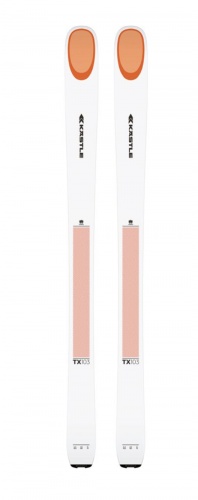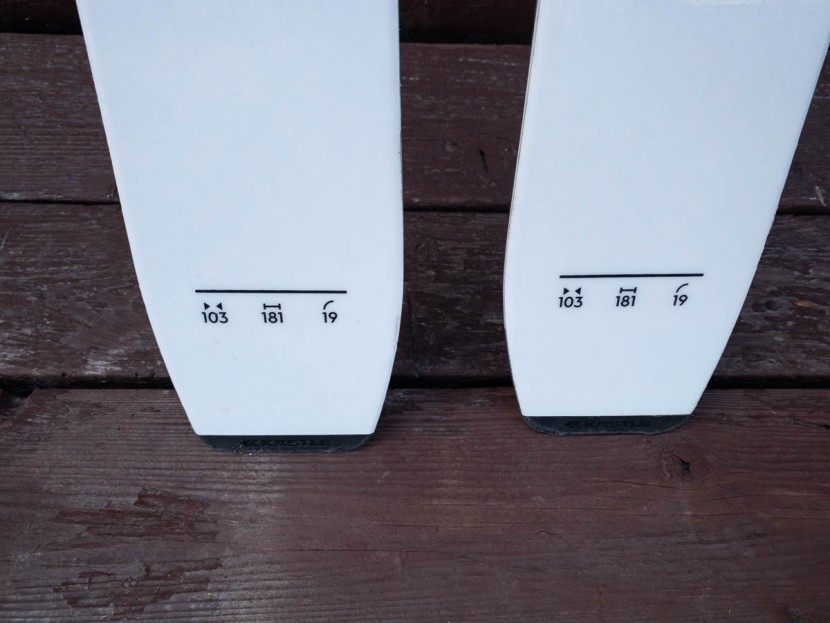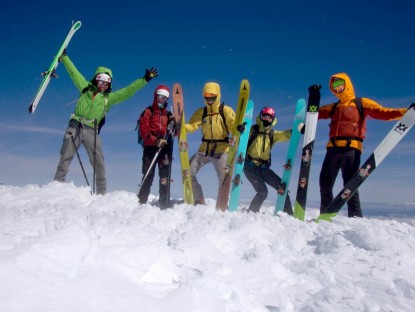Kastle TX 103 Review
Our Verdict
Our Analysis and Test Results
Stability, predictability, and uniformity of performance are the words that our test team agrees on to summarize the TX103. We can't call it “light” nor can we call the performance exciting. This is an excellent downhill ski at an above average weight. Its downhill performance is nearly perfectly balanced; it suffers in no conditions nor in any terrain.
Weight
One of the tested TX103 skis (tested in size 181cm) weighed 1708g and the other weighed 1772. We weighed the skis on a calibrated, cross-checked digital kitchen scale. All ski models show differences between one ski and the other. The spread between the tested TX103 skis is perhaps a bit above average, but we definitely did not notice it. If you want a conversion, the pair of TX103 skis weigh 7.6 pounds.
These numbers put the TX 103 in an upper weight class, as compared to other touring skis. Most human-powered skiers will justify this amount of weight only for maximum downhill performance and durability. With options on the market that are 2/3rds the weight of the TX103 (and excellent, comparable options that weigh at least 10% less) you will choose these for their downhill performance and robust construction, not for efficiency.
Stability at Speed
We like the downhill performance of the Kastle TX103 across the board. We can't say it excels in any one way, but it is more consistent than almost any other choice. In terms of speed, intermediate to expert skiers will have these sticks keep up at speeds well beyond the risk tolerance of most.
We examine too, here, the stability in the steeps. In steep and confined terrain we like the solid platform “feel” and the seemingly perfectly balanced, fore and aft, the tenacity of the 103's edge grip. Neither tip, tail nor underfoot is grabbier than the others.
Firm Snow
We don't generally expect touring skis over 100mm to be great on firm snow. Sure, your resort skis do really well, and they're 110mm plus. But, those resort skis have metal and multiple layers of laminated materials to support the edge forces sustained in icier conditions. Light touring skis, generally, get their firm snow grip from geometry more than from materials. The TX103, though, isn't a light touring ski. As such, it sort of “breaks the rules” and uses that mass allowance to include more and stiffer materials (in terms of torsional rigidity) that help in hard snow conditions. We like the firm snow performance of the TX103.
Powder
Just before Grand Teton National Park closed during the early days of the Covid-19 crisis we scored a huge, high powder day that this legendary backcountry venue is known for. We skied nearly 8000 feet of varied, steep, and rowdy skiing; all of it in nearly perfect powder snow. The TX103 was our test sled that day. We picked them up from the shop the day before. With zero adjustment, our expert tester that day was able to enjoy every single turn, from start to finish. These Kastle skis are perfectly predictable in powder snow. They aren't “flashy” or trendy. We have had a similar experience with prior Kastle skis. You can step in and find them immediately familiar and comfortable. You won't be blown away by the skis; let the snow do that for you. We'd call the TX103, in powder snow, a sort of “quiet crusher”. They don't beg attention. They simply enable one of nature's finest athletic experiences.
Crud/Poor Snow
We had to work hard the winter and spring of 2020 to find poor snow. But, we do that hard work. For you. Our lead test editor rode the TX103 on a crusty, ranging tour on all aspects of Teton Pass' Taylor Mountain in late March. He would have preferred to be high in Grand Teton National Park that sunny day, but Covid closures changed his patterns. The upshot is that we get to report on his 8000 feet of marginal skiing. We handed the skis around, of course, but our poor snow conclusions are largely drawn from that one day.
In short, these are excellent skis for poor snow. We won't credit that performance to any one or even a combination of construction attributes. There are many variables in ski construction and materials. It is a ski reviewer's crutch to cite geometry and materials. The TX103 has pretty “bland” catalog copy. Kastle lets the skis do the talking. What they tell us about poor snow skiing is “evenness”. Edge-to-edge, and tip-to-tail the TX103 in poor snow is a balanced, centered dream. We are pretty tuned into how and when different ski models force us (and other skiers) into survival mode in tougher conditions. The TX103 allows dynamic, “normal” turns well into the spectrum of poor conditions. You won't even notice the zipper crust. Mildly “upside down” soft snow remains fun and floaty. Well-waxed, the “suckiest” slop snow doesn't faze the TX103. You'll “step back” to snowplows and stepped turns only when the refreezing crust is enough to slash shins or grab pole baskets right out of your hand.
Value
We've not before used the term “value” to describe tested Kastle skis. The previous generation of TX skis from Kastle was lighter, fragile and more expensive. The downhill performance was similar to that of this TX103, but you paid for it up front and with shortened operating life. We tested the (now discontinued) TX98 to failure and hope to do the same with the TX103. Given the weight of the TX103 we fully expect to go quite a bit longer with them. The TX103 is also less expensive at initial retail than the TX98 was.
Conclusion
We like the TX103. However, we can't help but compare it to its discontinued predecessor. The TX98 was the best performing touring ski we've ever used. We put multiple hundreds of thousands of vertical feet on it. The TX103 performs very similarly on the downhill, but is about 140% the mass of the 98. That is a significant energy suck on the way up. The 103 is less expensive and likely more durable than the 98 was.











